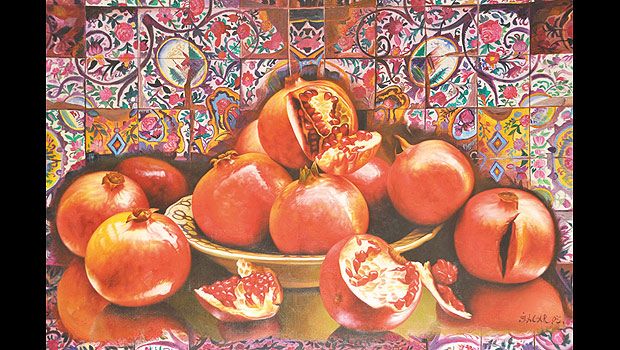
“Pomegranate: The Mystic Fruit of Heaven” was the theme accompanying the three-day (Feb. 28 – March 1) Diplomacy of Art Exhibition that featured the works of renowned Turkish artist Ismail Acar at the residence of Turkish Consul General Salih Mutlu Sen.
The pomegranate holds a prominent symbolic position in many religious traditions and ancient myths and is usually associated to fertility, longevity and passage to the afterlife. The Qur’an considers, for instance, the pomegranate a fruit from heaven and prescribes every single aril to be eaten.
The blessed fruit, rich in mythical symbolism, represented a source of inspiration for Acar, an artist looking for constant creative stimulus within his own religious and cultural tradition.
As for the title of the exhibition, Diplomacy of Art, the idea was to pay homage to the first cooperation between a diplomatic mission in Saudi Arabia and BMG Foundation, a 16-year-old organization, aiming at bridging Eastern and Western cultures through the promotion of cultural and sports events.
Organized by Turkish Consul General Sen and Chairman of BMG Foundation Basil Al Ghalayini, the exhibit saw consistent participation from Jeddah’s local community, including Saudi officials, diplomats, emerging Saudi artists, journalists and art lovers willing to meet a prominent Turkish painter who was awarded Turkey’s most successful artist in 2004 and participated in over 200 personal and group exhibitions all over the world.
“Islamic culture represents my ‘innovative’ starting point. I use the word innovative as Turkish artists have been for centuries influenced by Western cultures, forgetting about their own roots,” said Acar at his exhibit’s inauguration last Tuesday.
“Great masters like Leonardo Da Vinci, whose masterpieces are fundamental parts of the history of art, highlight the centrality of Christian tradition in painting. This made me eager to explore more my own tradition, research Islamic symbols and icons and find my own aesthetics,” he added.
Two important Islamic icons, Prophet Muhammad’s (peace be upon him) bow and sword, carrying for Muslims the same value that the last supper has in Christianity, were painted and presented for the first time by Acar on the special occasion of the Diplomacy of Art Exhibition.
“These items have traveled throughout the centuries. They first belonged to the Hijaz and afterward were carried to Egypt and Istanbul. Presenting my paintings in Jeddah, I have symbolically brought them back to their homeland,” said Acar.
Stylized oriental, Islamic and Turkish motifs and objects permeate the work of the painter who brings a contemporary view on history, mingles traditional painting techniques with modern technology and searches originality and uniqueness in the respect of his tradition and roots.
Acar’s exhibits displayed, until now, themes and symbols including caftans, tulips, roses, pomegranates, whirling dervishes, eastern icons, scripts, calligraphic art and beautiful representations of the city of Istanbul with its famous Hagia Sophia church.
The entire Pomegranate Collection along with other famous pieces were showcased in Jeddah. Particularly fascinating are the representations of the artist’s hometown Istanbul, a melting pot of cultures depicted in three main moments of its history: the Byzantine, Ottoman and Republican.
Acar’s capacity to represent modern Turkey through the lenses of its history was particularly appreciated by Sen that compared him to contemporary prominent Turkish novelist Orhan Pamuk.
“Using different means to express their talents, both artists focused on the religion, costumes and traditions of their homeland and town, grasping the Zeitgeist, the spirit of the time,” said Sen.
“They both understood the need for nations, societies and individuals to find nourishment in diversity, recognize and respect other cultures and, at the same time, preserve their genuine identity. Pamuk efficaciously expresses this concept in his novel, ‘The Black Book,’ where he exalts the beauty of Istanbul’s curved, small and narrow alleys that distinguish the city from other major capitals like London and Paris and make it unique,” he added.
Besides the Istanbul pieces, equally captivating are the paintings from the Sultans Collection that the artist presented at the 51st International Biennale of Venice in June 2005. The Sultans in Venice Exhibit was displayed at 23 different palaces, buildings and museums along the Grand Canal.
Acar also displayed his works at the Hagia Sophia Museum in 1999. The exhibition attracted 350,000 people and was the first artistic manifestation to take place in the 1,600 years history of the Hagia Sophia.
Reflecting Turkish-Islamic culture in his artworks, Acar not only contributes to nourish his local artistic scene, representing a valid ambassador of Turkish tradition abroad, but also serves the purpose of initiatives aiming at promoting cultural mélanges.
“Through the Artalive initiative, BMG Foundation is trying to provide the Saudi art scene with the right platform to be known internationally. We try to give Saudi artists the opportunity to display their works abroad and, at the same time, we invite internationally renowned artists like Acar to exhibit here and exchange views with them to enhance their potential and knowledge,” explained Ghalayini.
Apart from Artalive, BMG Foundation comprises the GCC Polo Cup and BMG Classics initiatives. The last one serves the purpose of educating the young generation to the listening and appreciation of classical music.
The Diplomacy of Art Exhibition is BMG’s first initiative in cooperation with consulates and embassies in Saudi Arabia. Similar events, displaying the works of renowned artists in association with their respective diplomatic representatives, will continue to be organized twice a year, in February and September.
As for Acar’s exhibition in Jeddah, the event also enjoys a philanthropic dimension. Since 2001, the artist decided in fact to share part of the income from the selling of his works with charity associations and institutions.
By ROBERTA FEDELE, ROBERTA.FEDELE@ARABNEWS.COM



